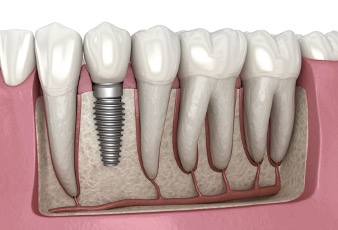Dental implants have been a major focus of my practice since 1989. Technology has improved immensely since that time to a success rate nearing 100%. Dental implants are now the gold standard for replacing missing teeth. This means it should be the first option for teeth replacement.
In this issue, we will discuss the most common questions about dental implants.
What are Dental Implants?
Dental implants are artificial replacements of the root of teeth that were removed. They act as anchors to support a tooth or many teeth. Dental implants are made from titanium or titanium alloy, the same material used in hip and knee replacements. Today, some implants are available in all-ceramic.
What are the Benefits of Dental Implants?
- Dental Implants prevent further loss of jaw bone. Preventing bone loss which occur with the loss of teeth, the facial structures remain intact. This is especially important when all of the teeth are missing because the face tends to collapse if implants are not placed.
- Overall quality of life is enhanced with replacement teeth that look, feel and function more like natural teeth. One will look younger and more attractive thus increasing confidence and self-image.
- Patients are likely to live longer because they will get to eat better and prevent malnutrition or stomach problems. Fresh vegetables and fruits should be placed back on the menu. Also, chewing is improved and digestion will be better as well.
- No more worries about your dentures moving around, popping out or causing discomfort. Implants are so securely attached that the fear of dentures falling out will be eliminated.
- The mouth will be restored as closely as possible to its natural state.
- Food will be tasted more completely. When wearing an upper denture, the palate is usually covered. This prevents enjoyment of the taste buds at the roof of the mouth. With dental implants the palate remains free and open.
- No more need for denture glue. That sticky and messy denture adhesive will be a thing of the past.
- Teeth on either side of the missing teeth remain intact and are not subjected to hooks and clasps to hold a partial denture in place. In bridges, it is required to grind down teeth on either side of the missing space in order to anchor a fixed bridge. Tooth structure can never be replaced and the long-term health of these teeth are compromised.
Can I have Dental Implants?
Most adults who are missing one or more teeth and are generally in good health is a candidate for dental implants. The biggest medical concern is un-controlled diabetes and chronic smokers.
Quality and quantity of bone for implant placement is another factor to consider. However, many persons can have additional procedures to grow and replace bone needed for dental implants. Advances in this type of treatment have made it possible for hundreds of our patients to now qualify for successful implant procedures. In addition, the 3D dental CT scanner allows us to “see” bone we cannot usually see on regular dental-rays.
Am I Too Old for Implants?
Overall health and the desire to improve your quality of life are much more important things to consider than one’s age. The ages of our dental implant patients have ranged from 18 to 91 (yes, age 91 and doing well).
Chewing food can be one of the pleasures to maintain along with a positive self-image. Many persons suffer when forced to wear dentures. Some patients even lose their dentures and do not have any aid to help them chew. When dental implants are placed, patients are assured that they will be able to chew and have teeth for the rest of their lives.
Dr. Kendal V. O. Major is Founder and CEO of Center for Specialized Dentistry which is a comprehensive family dental practice operating in Nassau and Freeport. He is the first Bahamian Specialist in gum diseases and dental implants since 1989. He also is a certified Fast braces provider. His practice is located at 89 Collins Avenue, Nassau at (242)325-5165 or [email protected].

Two teeth replaced with implants and crowns

Implant replacing the root of a tooth. The bone is now preserved.





